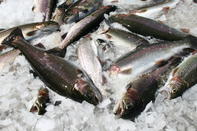
How to Harvest Freshwater Fish
Make sure fish are sorted in uniform sizes prior to harvest and starve the fish for 3 - 5 days prior to harvesting, sometimes even longer if the water temperature is low, slower metabolism advises Henk Stander principal technical manager of Aquaculture: Department of Animal Sciences at Stellenbosch University.
Starving before harvesting will empty the stomach content. Not only will it prevent any off-taste and microbial contamination but will ensure better overall hygiene and quality during the slaughtering process. Harvesting of trout is usually done during the early summer months and should, therefore, start early in the morning when temperatures are still cool.
Tilapia and catfish are harvested throughout the year. Avoid unnecessary handling of fish that might induce stress as well as causing fish to bruise and lose scales, thus affecting the quality of the produce.
Humane Killing of Fish
Fish can be killed by adding an anaesthetic to the water in the harvesting tanks, such as a water-soluble liquid anaesthetic for fish, crustacea and abalone. It has no withdrawal period and can be used to sedate fish for transport (1 - 5 parts per million) or for ‘rested harvesting’ (15 - 20 ppm).
This means fish are anaesthetized and feels no pain. After harvest, store fish below 5℃ by covering them with layers of ice or ice slurry. Ice should be ready before harvest; buy ice or make your own. Deliver the correct quantities of fish in clean bins to the processor at the time and date agreed upon, but it is good practice to send a sample of 50 - 80 kg of fish to the processor for testing before the main harvest.
The test sample will be evaluated for taste, general appearance and in the case of trout, for meat colour. Only after the sample has been approved, should the rest of the fish be delivered.
Furthermore, the fish farmer should also arrange for freezer storage facilities of harvested and gutted fish in cases where it is not possible to deliver fresh fish to processing factories.
When to Harvest Fish
Freshwater fish species are harvested at different weights, says Henk Stander, principal technical manager of the Aquaculture Division of Stellenbosch University. Trout is a seasonal fish and spawns in late spring or early summer. The minimum weight for trout is 1 kg, but the best prices per kg are achieved at 1,2 - 1,3 kg live weight.
Meat yield is about 80% (head and guts removed) to about 50% when filleted into portions. Tilapia and catfish spawn throughout the year and should be size grade at least three times during their growing season. Smaller fish are separated from larger fish by a grading grid and the larger fish are transferred to another dam or tank.
If fish are not size graded, larger fish will eat first, preventing smaller fish from eating enough. This will lead to the growth rate and size difference between smaller and larger fish becoming too varied, explains Henk. Tilapia are harvested at approximately 250 - 300 g when sold as whole fish. When tilapia is sold to be filleted (fish meat cut into portions) then the ideal weight should be 0,8 kg - 1 kg.
Sharptooth catfish also has a continuous spawning season and also need to be size graded throughout their lifespan. Catfish are only sold as portions and the ideal fish weight is 1 kg. Commercial harvesting of farmed carp is limited due to poor prices and negative customer perception in South Africa.
By Marinda Louw